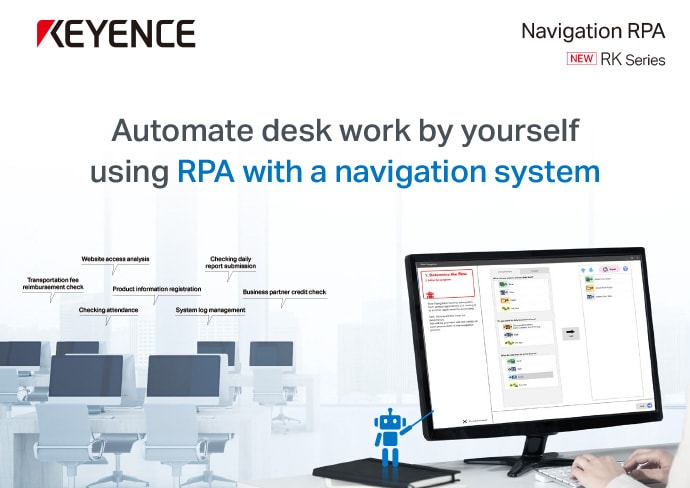Tokyo Metropolitan Hospital Organization
The integration work with Excel that used to take an hour every day has been shortened to just 10 minutes by using RK. Thanks to the free accompanying support, even if we are unsure how to build something, we are always guided to a solution!
The Tokyo Metropolitan Hospital Organization is a public independent administrative corporation with roughly 17,000 staff members. They have decided to adopt KEYENCE’s RPA (robotic process automation) tool, called RK, to reduce time-consuming tasks that frequently bog down large organizations. While they are still in the early stages of promoting awareness and expanding the tool’s deployment, they have already achieved significant results such as reducing the time spent on some daily tasks from an hour to just 10 minutes in the departments where it was introduced. We asked Mr. Iizuka from the Business Development’s DX Center, who is responsible for system adjustments, about the background of RK’s implementation, how it is being used, and strategies for broader deployment.
Tokyo Metropolitan Hospital Organization
Established on July 1, 2022, the Tokyo Metropolitan Hospital Organization was created as a local independent administrative agency. It operates 14 hospitals as a unified medical group, leveraging each facility’s strengths to ensure high-quality medical care for all residents and contribute to a safe, secure Tokyo. As a public medical institution, it collaborates with the Tokyo Metropolitan Government, related organizations, and private healthcare providers to support the healthcare system of Tokyo, a major metropolis.
- Founded: July 1, 2022
- Number of Employees: approximately 17,000 (as of February 2025)
Utilizing RK for Business Process Improvement Across Multiple Hospitals and Headquarters
Please tell us about the current use of RK.
Currently, we have five “builder” licenses contracted within the organization. I personally use one in the Business Development Department, two in the Strategy Promotion Office, and two in the General Affairs Department. We started by automating familiar, everyday tasks and gradually expanded the scope of applications.
For example, we automate tasks like launching necessary apps such as ChatGPT and Office at the start of the day, or automatically logging into password-protected applications. Automating familiar tasks for the staff helps raise awareness of RK’s convenience internally.
In the Strategy Promotion Office, we have already completed an automation that solves a department-wide challenge. Specifically, it involves consolidating statistical data such as outpatient and inpatient numbers output from the EMR (electronic medical record) system into a single report. The EMR data from the 14 hospitals operated by our organization are stored daily as Excel files on a shared folder.
Previously, headquarters staff would open each file individually, then consolidate them into one Excel file for analysis. This manual process, which took about an hour daily, has now been automated with RK, reducing the task to less than 10 minutes. This has been extremely helpful.
Is the promotion of RK led by the Business Development Department?
Please tell us about the background of RK’s introduction.
Our organization was formed by merging two entities. Because of this, we are still a relatively new organization, but it inherited many “rogue” files like Excel and Word documents from before the merger. Only the responsible personnel knew which files were the latest, making it difficult to stay organized. I remember returning from parental leave and struggling to smoothly take over responsibilities because of this. While everyone in the headquarters shared the desire to reduce such “wasted time,” no one knew how to tackle the problem. Then, at one point, my former boss suggested that using an RPA application I had used in my previous job might solve the problem, which prompted us to consider implementing RPA.
After comparing several third-party products, we decided on RK. With approval from the finance department, we initially started with a pilot by purchasing one “builder” license around March 2023. From there, we used RK to automate multiple tasks, and after testing it with other departments, we found it very user-friendly and believed it could effectively address our issues. By December 2023, we added four more “builder” licenses, bringing the total to five, which are now used across three departments.
Key factors in our decision to adopt were “User-friendly UI” and “Free accompanying support”
What made you choose RK?
The main reasons were “user-friendly UI” and the “free accompanying support.”
User-Friendly UI
The ease of setting commands through drag-and-drop was very attractive. Also, the fact that the functions related to “MS Office,” which we wanted to handle, are provided as dedicated menus, gave us peace of mind. For example, pressing the “Excel” menu includes functions like “Open” and “Copy,” covering most needs. This made us feel that operation would be intuitive and straightforward.
Free Accompanying Support
From my research, most competing products only offer paid support. In such cases, organizations tend to try solving issues on their own, which can hinder automation progress. RK, on the other hand, offers free support that is very helpful. When we first implemented RK, the support was invaluable. They responded promptly and appropriately to our inquiries, guiding us to solutions. Looking back, I realize I sometimes asked questions in a rough manner, but they always responded politely without any annoyance, which was very reassuring.
RK as a “Tool Connecting Hospitals and Headquarters”
What kind of “rough questions” did you ask?
For example, I once asked to “convert multiple Excel files with different formats into a unified format,” by zipping them and handing over the task as a “black box.”
In terms of fundamental “business improvement,” having multiple formats is inherently problematic, and standardization should be pursued. However, since our organization’s 14 hospitals and one facility operate almost as separate companies, unifying formats across all of them is difficult given the approximately 17,000 staff members. As a practical solution, we decided to automate format conversion using RK.
Automating the “format conversion” eliminated the burden on the hospitals and reduced the workload at headquarters. Furthermore, even if the formats sent from each hospital or facility change in the future, we can simply update the RK scenario to adapt.
RK has become a tool that smoothly connects our hospitals, facilities and headquarters, which are otherwise difficult to coordinate.
What are the tips for departments to autonomously and proactively promote automation?
Currently, multiple departments within the Tokyo Metropolitan Hospital Organization are independently creating scenarios and promoting automation. What strategies have you used to encourage organization-wide adoption of RK?
We conduct interviews to understand operational challenges, then create sample scenarios to solve those issues and hold presentations to share automation case studies. For those interested, we lend access to licenses so they can try using RK firsthand.
In that sense, I think it’s a good point that user licenses are not tied to individual IDs. If any licenses are not currently being used, anyone can try them freely, which encourages experimentation.
Although it’s not directly under my jurisdiction, I believe that senior staff proactively promoting RK utilization across departments and tools, especially within “Business Improvement PT,” has significantly helped spread RK’s adoption.
Future plans for further business improvement and broader deployment of RK?
Future plans
We want to further advance the “consolidation of statistical data” tasks in the Strategy Promotion Office. Specifically, we aim to generate data on patient trends for each medical department and hospital, which has been a time-consuming manual task so far. We are already developing an automation for this consolidation, and it’s nearing completion.
Additionally, the “Business Improvement PT” is considering increasing licenses and expanding deployment to hospitals. There are many tasks, such as inventory management in pharmacy departments, where RK could bring significant improvements.
On a personal note, I am also interested in exploring how to combine RK with generative AI. For example, having RK automatically generate meeting minutes after a conference would greatly ease daily work.
What do you expect from KEYENCE to support these efforts?
I hope the free accompanying support continues as it is now, as I plan to rely on it going forward. Also, the scenario “templates” uploaded to the RK support site have been very helpful, and I look forward to seeing more variations added.

Navigation RPA RK Series
View Catalog
